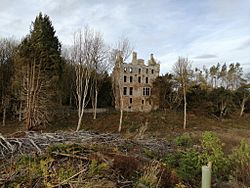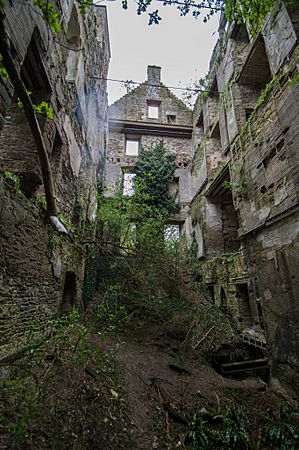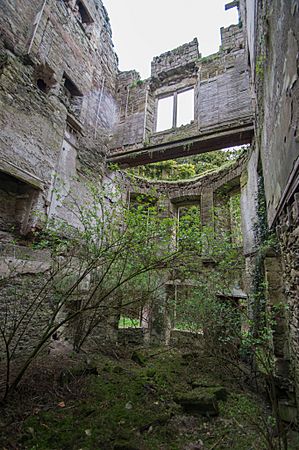Cavers Castle facts for kids
Quick facts for kids Cavers Castle |
|
|---|---|
| Cavers, Scottish Borders, Scotland | |

Ruins of Cavers House, which incorporates parts of former castle.
|
|
| Coordinates | 55°25′51″N 2°43′39″W / 55.43085°N 2.72739°W |
| Site information | |
| Condition | Ruined |
Cavers Castle, also known as Cavers House, is a ruined old building in the Scottish Borders area of Scotland. It's a type of strong house called a tower house.
This castle was once a much larger tower house belonging to the Douglas family. It was built around the 1400s or 1500s. Before that, an even older fort of the Balliol family stood on the same spot. Cavers Castle faced many attacks during the wars with England in the 1500s.
Later, in the 1600s, it was changed into a big mansion. It was made even bigger and more fancy in the 1890s. Sadly, in the 1950s, its roof was removed, and parts of it were pulled down. The castle was sold in 2019, and there are now plans to restore it.
Contents
History of Cavers Castle
Early Owners: The Balliol Family
The land and area of Cavers first belonged to the Balliol family in 1268. This is when Alexander de Balliol of Cavers is first mentioned in old papers. The church lands in Cavers were owned by Jedburgh Abbey even earlier.
During the Wars of Scottish Independence, Alexander Balliol was captured. This might have happened at the Battle of Dunbar in 1296. To get free, he fought for King Edward I of England from 1297. However, the English kept his son in the Tower of London to make sure Alexander behaved.
In 1311, English soldiers took over the castle. But after the Scots captured Jedburgh Castle in 1314, Cavers Castle isn't mentioned much. In 1358, Cavers was held by the Earl of Mar. The Balliol family had lost their lands because they were against Robert the Bruce.
The Douglas Family Takes Over
By 1368, the Earl of Douglas owned Cavers. He was called the lord of the Cavers area. This shows that some kind of main building was already there. In 1397, Cavers was owned by Isabel, Countess of Mar. She was the niece of Earl Thomas.
In the early 1400s, Isabel gave the lands of Cavers to her nephew, Archibald Douglas. He was one of the two sons of James, Earl of Douglas. King Robert III disagreed with this and gave the lands to someone else. But Archibald had his ownership confirmed by King James I in 1412. He also became the Sheriff of Roxburgh, which was an important local job.
It's likely that Archibald Douglas built the tower house that became the main part of Cavers Castle. This tower was built in the 1400s or early 1500s. The castle is first mentioned in a document from 1511.
Wars and Changes in the 1500s
William Douglas of Cavers was liked by King James III. He and his followers fought for the king in the battle of Sauchieburn in 1488. Later, King James IV forgave them. A document from 1509 says that William Douglas of Cavers was killed fighting the English.
In 1511, King James IV made Cavers Castle and its lands a special area called a "free barony" for Sir James Douglas. In 1523, the area of Teviotdale was attacked by the English. Its strongholds, including Cavers, were damaged. This happened again in 1542.
During a war known as the Rough Wooing, Cavers tower was likely attacked and damaged more than once. In 1547, after the battle of Pinkie, William Douglas of Cavers promised loyalty to King Edward VI. This showed that the English were in charge of Teviotdale at that time.
By the late 1500s, Cavers Castle was shown on maps as a tall tower with a protective wall and other buildings. After King James VI stopped guarding the border in 1621, the castle no longer had a military role. From then on, it was mainly a home for the Douglas family.
Life at Cavers and Later Years
In 1617, King James VI visited Cavers on his way to Edinburgh. He even knighted someone there. Sir William Douglas, the ninth owner of Cavers, supported the National Covenant. This was an agreement signed in 1638 to protect the Scottish church. The Hawick Covenant, which he signed, was kept at Cavers.
The estate faced money problems in the late 1600s and early 1700s. The Douglas family also had trouble, with many owners being succeeded by brothers or cousins. The last direct male Douglas line ended in 1878.
Old maps from around 1750 show that Cavers House was the center of a large estate. But it didn't have many fancy gardens. Later photos show that by the late 1800s, the house had been made much bigger. It looked like a large country house, and the old tower was hidden within it.
In the 1890s, the house was updated in a grand style. This was likely expensive for the estate. After the two World Wars, the estate faced more difficulties. In the 1940s, the house finally got electricity. However, after the owner died, taxes on inherited property meant the estate had to be broken up.
The house couldn't find a buyer. After its roof was removed, it was used for training exercises in 1954. Then it was sold off with the rest of the estate. Today, only the shell of the old tower and part of the attached mansion remain.




